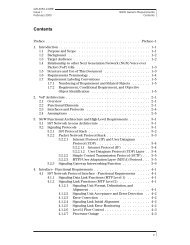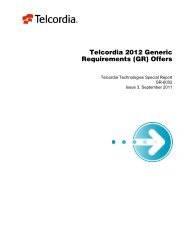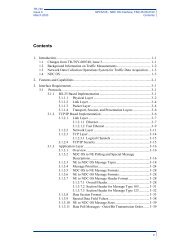(NGN) Documents - Telcordia Information SuperStore - Telcordia ...
(NGN) Documents - Telcordia Information SuperStore - Telcordia ...
(NGN) Documents - Telcordia Information SuperStore - Telcordia ...
Create successful ePaper yourself
Turn your PDF publications into a flip-book with our unique Google optimized e-Paper software.
ROADMAP-TO-<strong>NGN</strong>-1<br />
Roadmap to <strong>NGN</strong> <strong>Documents</strong> Issue 2, August 2008<br />
Your Roadmap to <strong>NGN</strong> <strong>Documents</strong><br />
3–2<br />
SR-NOTES-SERIES-09, <strong>Telcordia</strong> Notes on CPE for Next Generation<br />
Network Access<br />
SR-NOTES-SERIES-11, <strong>Telcordia</strong> Notes on IP Centrex.<br />
3.2 <strong>NGN</strong> Generic Requirements (GR) <strong>Documents</strong><br />
This section lists all the <strong>Telcordia</strong> Generic Requirements (GR) documents related<br />
to <strong>NGN</strong>. A Document Abstract and an abridged Table of Contents for each<br />
document is provided. For the user’s convenience, all the GR documents listed in<br />
this section are available individually or as a complete set. The set ordering number<br />
is FR-<strong>NGN</strong>-01, <strong>NGN</strong> Family of Requirements.<br />
GR-3051-CORE, Voice over Packet: <strong>NGN</strong> Call Connection Agent Generic<br />
Requirements<br />
Today's Public Switched Telephone Network (PSTN) is engineered to efficiently<br />
transport voice traffic and services. However, the volume of data traffic (e.g.,<br />
Internet traffic) carried by the PSTN is growing rapidly, and soon it will exceed the<br />
volume of voice traffic. This suggests that, going forward, it will be more efficient<br />
to engineer and operate networks optimized to handle data traffic. Packet-based<br />
transport and switching technologies are logical choices for such networks. In other<br />
words, voice traffic should be packetized and handled like data in the future. As<br />
data traffic continues to grow, users of network services are increasingly seeking<br />
value-added, multi-faceted communications capabilities such as unified messaging<br />
and complete service/terminal mobility. Users are also seeking higher<br />
communications bandwidths and greater control over that bandwidth. A Voice over<br />
Packet (VoP) network is envisioned as the first evolutionary step in satisfying these<br />
demands, while enabling new services and revenue streams to network providers,<br />
and potentially reducing the management costs and time to market. SR-4717, Voice<br />
Over Packet in Next Generation Networks: An Architectural Framework, provides<br />
a comprehensive framework for the support of voice and other narrowband<br />
services over packet-based networks. Such support includes traditional access<br />
methods, signaling interfaces, call processing, vertical services, and accounting.<br />
Moreover, these functions are distributed across the following functional entities:<br />
Trunk/Access Gateways, Signaling Gateways, Call Connection Agents, Service<br />
Agents, and Billing Agents. GR-3051-CORE provides the <strong>Telcordia</strong> view of<br />
proposed generic requirements and objectives for a Call Connection Agent. In<br />
general, these requirements can be divided into four groups: interface requirements,<br />
connection control requirements, call processing requirements, and management<br />
and operations requirements. These requirements also align with standards and<br />
also adds support for Fax relay, Fax Store and Forward, Customer Gateways, and<br />
Network Mediation Gateways.





